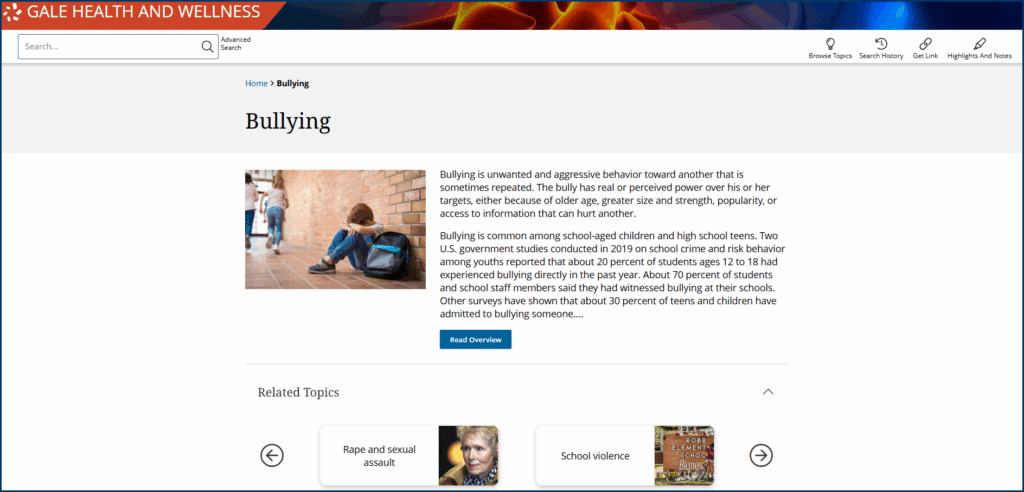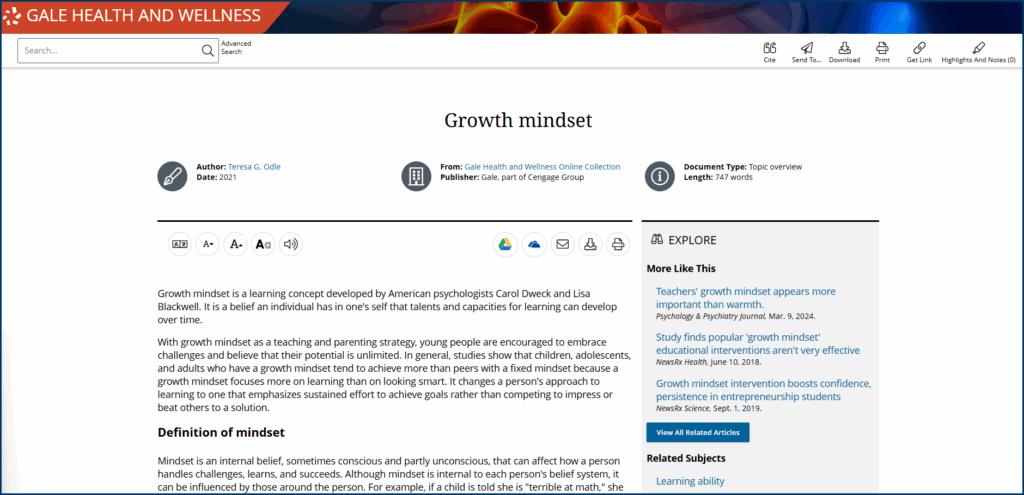Each year, nearly one in three US students between the ages of 12 and 17 reports being bullied. Of those, rates are significantly higher for girls (38.3%), students with a developmental disability (44.4%), and LGBTQ+ students (47.1%). National Bullying Prevention Month in October encourages educators, caregivers, and parents to take a closer look at how these patterns show up in classrooms and online.
The bullying topic page available through Gale Health and Wellness provides access to a curated collection of reader-friendly resources that help families understand what bullying looks like, its effects on emotional well-being, and how to respond. Gale Health and Wellness acts as a trusted ally in these efforts, offering students tools to process what they’re facing and regain a sense of control, while also helping families and educators support the young people in their lives.
What Does Bullying Look Like?
Bullying is a pattern of behavior where someone intentionally harms, intimidates, or tries to control another person through repeated mistreatment that thrives on an imbalance of power. Recognizing these patterns early requires understanding the range of behaviors that fall under the category of bullying and how they might evolve.
These behaviors fall into broad types, each with specific content available on Gale Health and Wellness that provides an overview of the information and related supplementary resources.
- Verbal bullying involves the repetitive use of language to control how someone feels about themselves through humiliation. It can take many forms: insults, slurs, threats—even something as seemingly minor as pointed laughter or exaggerated sighs when the student being mocked is nearby.
- Social bullying often happens within friend groups, in which a person is deliberately excluded and used as a target for others to gang up on. This makes it harder to recognize, as it can be dismissed as banter or friendly teasing. Because the harm comes from people they trust, those on the receiving end often feel especially isolated. The person on the receiving end may worry that confiding in the wrong person could make them more vulnerable or give classmates more to use against them.
- Physical bullying includes hitting and pushing, but also repeated “accidents,” blocking someone’s path, or damaging personal items. In many cases, the behavior escalates gradually, providing the aggressor with cover while the recipient becomes increasingly isolated and vulnerable.
Raising Awareness of Bullying Behaviors
Schools and public libraries don’t need a formal campaign to engage in awareness and prevention. A well-placed flyer near the parenting section, a digital guide on the homepage, or a display near teen fiction can all offer a low-pressure way for patrons to identify signs of bullying.
Signs someone may be experiencing bullying include:
- A pattern of losing or damaging personal belongings with vague or inconsistent explanations
- Unexplained drops in grades or participation, especially from previously engaged students
- Unexplained headaches, stomachaches, or other physical complaints without a clear cause
- Mental health concerns, such as mood swings or unusually withdrawn behavior
- Sudden changes in friend groups or frequent isolation during group activities
- A noticeable drop in self-confidence or an increase in self-critical comments
- Protectiveness over their phone or reluctance to share online activity
- Reluctance to go to school
Signs someone may be engaging in bullying behavior include:
- Admission to feeling bad after interactions, but without attempts to change behavior
- Repeated mistreatment of a particular peer through online or in-person comments
- Exclusion of others by leveraging and/or manipulating popularity, access, or group dynamics
- Defensive or dismissive attitude when called out on hurtful behavior
- Justification of unkind actions by calling them “jokes” or “drama”
How to Start the Conversation
Once you’ve recognized the signs, a simple conversation can be an early form of intervention. Naming what you’ve noticed without judgment can help a child feel supported—or give them a chance to change course—before the behavior escalates.
If You’re Concerned a Young Person Is Being Bullied
Many adolescents struggle to articulate their experiences. They may not have the language, or they may not feel ready or comfortable discussing potentially related topics like sexual orientation or gender identity. In that context, the most helpful adult is often the one who doesn’t require the full story in exchange for guidance.
1. Begin by making an observation about a change in behavior or mood, without jumping to conclusions
When adults point out changes in a student’s behavior, it can sound like the start of a reprimand—even if that’s not the intent. Framing it as a neutral observation shows that you’re not asking for an explanation or suggesting they’ve done something wrong. You’re simply showing that you’ve noticed a change and care enough to check in, so the door stays open for conversation without putting the child on the defensive.
- “I’ve noticed you’ve been sitting alone at lunch lately.”
- “You’ve seemed quieter than usual in the past few weeks.”
2. Let them know they can take their time
You’re not necessarily trying to get them to open up on the spot, but to make clear that you’re a safe adult to talk to if or when they’re ready. Letting them set the pace of the conversation shows respect and patience, which helps build trust over time.
- “If something’s going on, I’m here to talk whenever you feel ready.”
- “It’s OK if you’re not sure how to explain. You can just share whatever feels right to you.”
3. Reassure them, but don’t minimize their experiences
Students who are being bullied often feel like it’s their fault or worry that their experience isn’t serious enough to talk about. A simple reassurance can counter that, as long as it doesn’t brush aside their emotions or try to solve the problem too quickly. You don’t need all the details to affirm that what they’re feeling matters.
- “No one deserves to feel unsafe or singled out.”
- “You’re not alone in this, even if it feels like it.”
If You’re Concerned That a Young Person May Be Mistreating Others
When discussing bullying with a student whose behavior raised concern, approach the conversation with honest curiosity. Not all harmful behavior stems from malice—sometimes it comes from immaturity, social pressure, or a failure to recognize how their behavior makes others feel—so you want to avoid a confrontation that might cause the child to shut down before you can get to the root cause.
A direct, calm conversation is more likely to result in the child being receptive to taking responsibility for what happened through genuine reflection and emotional connection.
Here’s what that might look like:
1. Describe the behavior, not the student
When a child feels they’ve already been defined by a label like “bully,” it makes it harder for them to see themselves any other way. Focus on specific actions that you’ve personally observed to give the student room to reflect without feeling cornered. It also protects the safety of others by keeping the focus on your perspective rather than on what peers may have said.
- “I’ve noticed you’ve been making a lot of comments about people’s clothes lately. Some of them seem pretty harsh.”
- “I’ve seen a couple of times during group work where you’ve been pretty quick to shut someone down or laugh when they’re talking.”
2. Reassure first, then invite reflection
Students are often more open to self-reflection when they’re not bracing for punishment. Make it clear that your role is to listen—not to accuse—so they’re more willing to open up for a collaborative discussion.
- “I’m not here to get you in trouble. I want to understand what’s going on.”
- “Before we talk about what happens next, it’s important to me that I understand your perspective.”
Once the student knows you’re coming from a place of support, you can ask thoughtful questions that encourage them to consider the impact of their behavior.
- “Can we talk about how those comments might make other people feel?”
- “How might that influence the way others see you?”
3. Emphasize accountability and the potential for change
Some students assume that once they’ve crossed a line, there’s no coming back. Remind them that growth is possible and that you’re willing to walk alongside them as they figure out what to do next.
- “You can’t change what’s already happened, but you do have control over what comes next.”
- “If you want to make things right, I’m here to help you figure out how.”
Helping Students Build a Sense of Resilience
The ideal response to bullying is prevention, where adults intervene early and peers refuse to participate. However, when prevention falls short, the most meaningful support you can offer is to help children develop a sense of resilience, so they’re able to rebuild their sense of identity and agency.
That doesn’t mean telling students to tough it out. It means helping them stay grounded in who they are—even when others try to shame or isolate them. For that resilience to take root, students need consistent reinforcement from the adults around them: What they’ve experienced matters, but it doesn’t have to define them.
How that looks in practice will depend on the child and the context, but we’ve outlined a few ways to show up for students as they begin to work through what they’ve experienced.
Encourage Them to Reclaim Their Identity
For students who experience repeated bullying, the constant pressure to shrink themselves or tolerate mistreatment can lead to lasting changes in how they see their own worth. Studies have found that children who are frequently bullied are more likely to have lowered self-esteem, as well as increased self-criticism and self-isolation, even into adulthood.
The more this behavior is repeated—especially in front of peers—the more likely it is that a child will begin to believe that others’ treatment of them is deserved.
Adults can help by reminding the child who they are outside of what they’ve been through, reinforcing that their core qualities haven’t disappeared just because others are trying to define them as someone else.
These simple affirmations send a powerful message: No one else has the right or the power to define you. You are still you.
Restore Their Sense of Agency
One of the most disorienting effects of bullying is how thoroughly it can strip away a child’s sense of control. When everyday decisions—what to wear, where to sit, even when to speak—are repeatedly met with ridicule or exclusion, children start to distrust their ability to have a positive impact on their environment and conform to whatever they think will keep them safe from harm.
Unfortunately, low perceived control—a person’s belief that they have little influence over their situation—tends to have a compounding effect on the efficacy of their coping skills. In contrast, students with stronger perceived control are more likely to act with self-direction and ask for help when they need it, which can lessen the long-term impact of bullying.
Rebuilding the confidence that bullying erodes means restoring a child’s sense of control, and that starts with giving them the power to make their own choices. A student who is used to being shut down or second-guessed might feel more confident making choices at home, like deciding what to cook for dinner or how to arrange their room. In a library or classroom, students might be choosing their seats or deciding whether to work alone or with a partner. What matters most is that their decisions are honored and their preferences taken seriously.
Model Self-Compassion
Even after the bullying ends, many young people continue to believe that something about them caused it. Over time, that belief can take hold as self-talk that turns everyday missteps into false confirmation of their own inadequacy.
To keep that voice from taking over, children need to develop self-compassion: the ability to respond to their own pain with the same patience and care they would offer someone they love. Practicing this kind of self-talk interrupts the reflex to self-blame and, instead, reminds them of their intrinsic worth.
When a student voices harsh self-judgment—“I’m so stupid,” “Nobody likes me,” “I mess everything up”—adults can respond with self-compassionate language that challenges those beliefs and models a more supportive way to think:
- “That really hurt my feelings, but it doesn’t mean I did something wrong.”
- “I don’t have to earn kindness by being perfect.”
- “Their behavior says more about them than it does about me.”
- “I’m allowed to feel upset right now.”
- “I’m doing the best I can, and that’s enough.”
- “This is hard right now, but it won’t always feel this way.”
Become a Community Resource for Bullying Prevention
In the aftermath of sustained bullying, kids stop expecting things to change. They lower their expectations about the possibilities the world has to offer, and instead, get stuck in the mindset that all they have to look forward to is their present reality.
Sometimes, what a child needs most is proof that their experience isn’t rare or permanent. They need to witness someone navigating adversity and coming out the other side, offering a reason to believe that change is possible. When libraries and schools make those stories easily accessible, and pair them with insightful resources from Gale Health and Wellness, you reinforce a powerful message: you are not alone.
Help your library become a safe space for tough conversations. Connect with your local Gale sales rep to learn how Gale Health and Wellness supports your patrons with trusted, stigma-free resources on bullying and emotional health.



